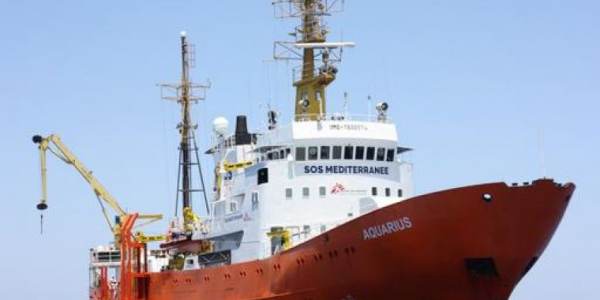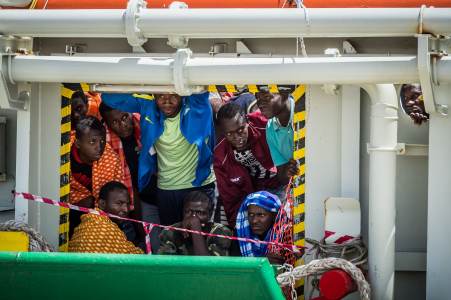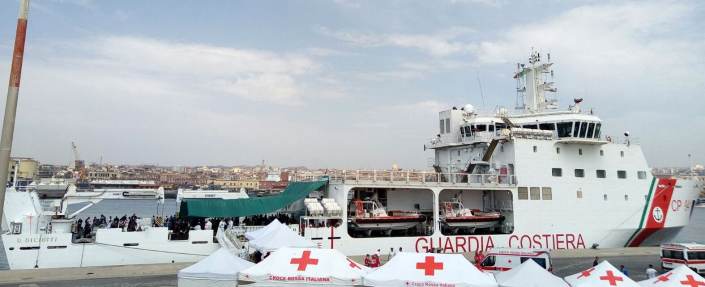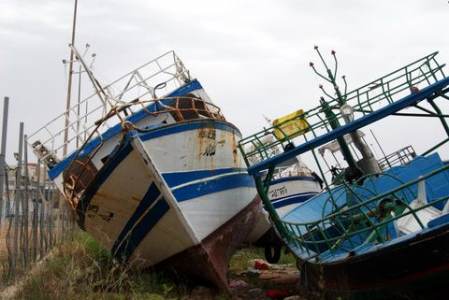The Case of the ‘Aquarius’ Being Forbidden from Accessing the Ports: Some Clarifications Regarding International Law
The case of the Aquarius, which remains blocked between Malta and Italy – and is currently pushed to move towards Spain – had called into question various elements of international law of the sea and the separations of juridical competence (or supposed competence) between Italy and Malta. These elements have been only partially cited and, in being rallied to the cause of political positions, the rights of those saved and states’ duties in relation to them have been forgotten, as is so often the case.
For this reason, it seems the correct moment to clarify some points.
 Issues relating to international law of the sea:
Issues relating to international law of the sea:
The duty of rescuing at sea is laid down and defined in a detailed manner both within customs of international law as well as within important agreements (above all, Article 98, paragraph 1 of UNCLOS). This said, the aspect relating to the duties of heads of states following a rescue remains extremely vague, or rather the indications regarding the specific criteria by which state must act in identifying a so-called “port of safety” where a landing can be organised. This uncertainty is the cause of a dangerous discretionary use of power by states, who are able to reject or accept a landing of rescued persons in their own ports or, alternatively, attempt to impose a landing of survivors in the territory of another state.
Over the last 20 years, practice has shown that, aside from causing controversies between states, such an absence of regulatory precision can be the cause of serious incidents of misunderstanding, to the detriment of the survivors themselves. For example, we can refer to the incident of the Tampa. In this instance, thanks to the refusal of entrance into Australian waters, the 433 survivors – rescued by a ship with a maximum capacity of 50 people, forced to change route towards Indonesia – were blocked at sea for days without food and in desperate medical situations. The justifications presented by the Australian government, which had been informed of the fact that many of the survivors risked dying, included that their responsibilities to the rescue had concluded after the intervention of Australian medical services to assist and hold up the medical emergencies.
Nine months after the Tampa incident, the issue of the sit for the transportation of shipwreck survivors was discussed by the International Maritime Organisation (IMO), which attempted to clarify the existing procedures through the adoption of two resolutions emending the SOLAS convention (Ris. MSC. 153 (78), 20 May 2004) and the SAR convention (Ris. MSC. 155 (78), 20 May 2004) respectively, which became active in July 2006. The amendments underline the obligation for command to rescue anyone who finds themselves in danger at sea and for the states responsible for the relevant SAR zones to undertakes all measures necessary until the rescue operations reach a good conclusion (Article 3.1.9 of the SAR convention). As far as the identification of a port of safety is concerned, the amendments establish that:
“The Contracting Government responsible for the search and rescue region in which such assistance is rendered shall exercise primary responsibility for ensuring such co-ordination occurs, so that survivors assisted are disembarked from the assisting ship and delivered to a place of safety, taking into account the particular circumstances of the case and guidelines developed by the Organization. In these cases, the relevant Contracting Government shall arrange for such disembarkation to be effected as soon as reasonably practicable” (italics added).
Yet again, the regulation seems vague and far from introducing an obligation for the requested state to allow a landing on its own territory, the responsibility instead being limited to cooperation with and coordination of efforts to bring people to a “place of safety”.
The amendments to the SOLAS and SAR conventions were then furthers by the ‘Guidelines in the Treatment of Persons Rescued at Sea’, itself adopted by the IMO in 2004 (IMO, Maritime Security Committee (MSC), Guidelines in the Treatment of Persons Rescued at Sea, IMO Resolution MSC. 167(78), adopted 10 May 2004, IMO Doc. MSC 78/26/Add.2 Annex 34). This was designed to support the effective application of the amendments, with special attention on the “humanitarian obligations and obligations under the relevant international law relating to treatment of persons rescued at sea”.
In substance, the guidelines confirm and clarify the norms of which we have already spoken, adding further detail on the key principles that govern the norms and defining some of the procedures that ship commanders and states ought take into account and follow in order to guarantee that the principle objectives of rescue at sea are met without the rescuing ships needing to take on excessive responsibilities. In particular, the concept of a “port of safety” is defined in considerable detail: “a location where rescue operations are considered to terminate. It is also a place where the survivors’ safety of life is no longer threatened and where their basic human needs (such as food, shelter and medical needs) can be met. Further, it is a place from which transportation arrangements can be made for the survivors’ next or final destination” (par. 6.12, italics added).
The guidelines also establish that, in contrast to the statements of the Australian government in relation to the Tampa, a ship that intervenes to prove rescue cannot be considered a place of safety, inasmuch as it is not equipped with services and crew capable of assisting those rescued in an adequate manner without putting its own security at risk. For this reason, “even if a ship is capable of safely accommodating the survivors and may serve as a temporary place of safety, it should be relieved of this responsibility as soon as alternative arrangements can be made. A place of safety may be on land, or it may be aboard a rescue unit or other suitable vessel or facility at sea that can serve as a place of safety until the survivors are disembarked to their next destination” (paragraphs 6.13 and 6.14).
The guidelines further establish that states ought cooperative in order to provide a place of safety for the survivors, after having adequately considered the determining factors and relevant risks (paragraph 6.16). It is worth noting that this has particular importance for cases in which there are refugees or asylum seekers among the survivors, inasmuch as the it maintains “the need to avoid disembarkation in territories where the lives and freedoms of those alleging a well-founded fear of persecution would be threatened” (paragraph 6.17). The ideas of the 2004 guidelines were then substantially reprised in the ‘Principles Relating to Administrative Procedures for Disembarking Persons Rescued at Sea’, adopted by the IMO in 2009.
What emerges, therefore, is that while agreements relating to the law of the sea do not go beyond the indications of obligations connected to landing procedures (IMO, Facilitation Committee, Principles Relating to Administrative Procedures for Disembarking Persons Rescued at Sea, IMO Doc. FAL.3/Circ.194, 22 January 2009), the guidelines provide important and salient indications, anticipating further indications that derive from regulations relating to the protection of human rights, according to which the landing operation ought be effected in the minimum time possible and with full protection of the human rights of those who have been rescued. Among other issues, one recalls in particular the resolution adopted by the European Council in 2011 (European Council, Parliamentary Assembly, Res. 1821 (2011) on the Interception and rescue at sea of asylum seekers, refugees and irregular migrants, adopted 21 June 2011), which remarks that states continue to interpret concept of a “place of safety” in different ways, and invites states to move towards a common definition, according to which the council refers to “a place which can meet the immediate needs of those disembarked and in no way jeopardises their fundamental rights, since the notion of ‘safety’ extends beyond mere protection from physical danger and must also take into account the fundamental rights dimension of the proposed place of disembarkation” (paragraph 9.5).
Aside from issues relating purely to the law of the sea, it also seems that the protection of the human rights of the rescued migrants is frequently forgotten. This includes not only the rights laid down in the Geneva Convention of 1951 and the principle of non refoulement which, in being a regulatory norm, has to be respected by all states – but also includes the European Convention on Human Rights, adopted by both Italy and Malta, as members of the European Council. In particular, the detention of migrants – including pregnant women and children – for days on board an exposed vessel at sea could be in violation of Article 2 (right to life) and Article 3 (prohibition of torture and other inhuman or degrading treatment) of the European Convention, as well – in cases of extended detention – of Article 5 (right to freedom and security).
On the debate between Italy and Malta:
In order to provide some clarity about the obligations under international law in relation to the case of the Aquarius, it is necessary to focus on a different issue about what is happening in the Mediterranean recently, i.e. the continuing debate (as well as rejection of responsibilities) between Italy and Malta. First of all, it ought be clarified that, in contrast to that which has been erroneously published by parts of the press, Malta has indeed ratified the Hamburg Convention of 1979. As far as the SAR zone is concerned, during the IMO Conference in Valencia in 1997, a “General Agreement on a Provisional SAR Plan” was established, defining the limits of the Mediterranean SAR zones (Cfr. F. CAFFIO, “Glossario di Diritto del mare”, in Rivista Marittima, May 2007: www.marina.difesa.it).
However, Malta does represent an exception from this process of agreeing the limits of SAR zones in the Mediterranean inasmuch as, according to the Global SAR Plan (developed by the IMO in order to provide information about national organisations to relevant services of Search and Rescue), Malta unilaterally established the SAR zone of its own competence. It has a vast area (equivalent to 250,000 km2, i.e. 750 times that of its territory and a little less than the territory of Italy), which coincides with its Flight Information Region (FIR) and in the North and to the West overlaps with the corresponding Italian SAR zone as established through DPR 664/1994, in particular including both the waters of Lampedusa and Lampione. The western part of the Maltese SAR zone overlaps with Tunisian territorial waters, thus impeding Tunisia from undertaking independent SAR operations a few miles from its own coastline.
An analogous case to that of Malta is that in the Aegean Sea, where Greece has a SAR zone (again, coinciding with its FIR) that Turkey does not recognise, but with the fundamental difference that Greece, thanks to its aeronautical spread across the large number of islands around the Turkish coast, is effectively able to enact an efficient rescue operation. By contrast, even if Malta has increased its resources over recent years of acquisition with European funds (e.g. four Australian motorboats), Malta still lacks the vehicles necessary to guarantee the action necessary for timely rescues in such a vast area. For this reason, Malta has been repeatedly forced to request the intervention of Italian rescues to aid if not replace its own operations (such as in the case of the Pinar on 18 April 2009: on this occasion Valletta refused the Turkish vessel Pinar to land, which had saved 144 migrants in the Maltese SAR zone, 50 miles south of Lampedusa. The landing was then authorised by Italy for Porto Empedocle (Sicily) on humanitarian grounds. The episode pushed the Italian government to look for an interpretative solution at a European level). This situation has also meant that, through an agreement, Malta has assigned Greece with surveillance of the Eastern area of its SAR zone, and in 2008 agreed on a memorandum of cooperation in the SAR zone with Libya.
Furthermore, it ought be noted that Malta has repeatedly refused to adhere to the amendments of the SAR and SOLAS conventions adopted in 2014, which establishes that the obligation to provide a place of safety for shipwreck survivors “falls on the government responsible for the SAR zone in which the survivors have been rescued”.
Malta’s position derives from its own economic interests: Valletta receives aid from the EU in relation to the extension of its own SAR zone, the southern border of which constitutes more than 1,000km of “Fortress Europe’s curtain wall” (cfr. F. Caffio, “L’emergenza immigrazione riaccende la tensione tra Italia e Malta”, in Affari Internazionali, 22 aprile 2010).
It is also necessary to remember that Malta’s refusal, and opposition from Italy deriving from this, has already produced serious consequences in the past, such as the case of the second mass shipwreck of Lampedusa in 11 October 2013 (see F. Gatti, La verità sul naufragio di Lampedusa, “Così l’Italia ci ha lasciati morire”, L’Espresso, 7 November 2013. A video interview with Mohanad Jammo can be accessed at video.espresso.repubblica.it). From the witness accounts especially, it has been reconstructed that on the night between 10th and 11th October 2013, a Libyan motorboat let off rounds of machine gun fire which not only wounded two of the passengers but also hit the boat transporting the 489 refugees – all of them Syrians, including 150 children – to the extent that the vessel began to gain water. At this point the Tunisian boat driver was forced to call the rescuers. The first telephone call was made at 11am and the staff in the MRCC in Rome, having received the GPS position through the passengers’ smartphones, and the position of the ship, closed the telephone call, implying that the rescue operation would be arriving. At 12.30 the vessel was still in the middle of the sea and no Italian vessel was in sight: it was a surviving Syrian doctor who then called the rescue control room again, receiving a signal of reassurance. Another half hour passed, and the Syrian doctor called for a third time and received the response that, the vessel being in the Maltese SAR zone, it was the Maltese authorities that ought be referred to. “You are in an area of Maltese responsibility.” The GPS showed that the ship was no more than 110km from Lampedusa and 230km from Malta but – recalling the information above regarding the division of the Italian and Maltese SAR zones – the boat was in the area of Maltese responsibility. The first Maltese ship arrived around 6pm: too late to avoid the death of 266 people and to the clear detriment of the undelegable principles of guaranteeing the security of persons and respect for their human rights.
The case of the Aquarius, it should be recalled, is already the second case of migrants left on the waves for a period of days. The precedent is, in fact, the odyssey of the Sea Watch 3 which, with 232 migrants on board, was forced to remain in unstable maritime conditions for three days before being given authorisation by Italy to land in an Italian port, Reggio Calabria. In this case, the concession by Italy was reached following a long stand-off with Malta which, even though it provided its own contribution to the rescuing operation and declared itself in charge of the vessel, refused to allow the migrants to land at Valletta.
Beatrice Gornati
Project “OpenEurope” – Oxfam Italia, Diaconia Valdese, Borderline Sicilia Onlus
Translation by Richard Braude




